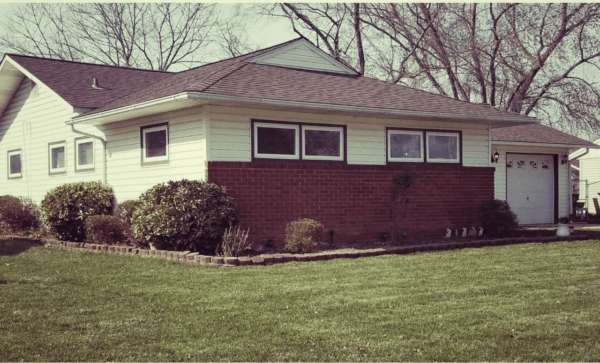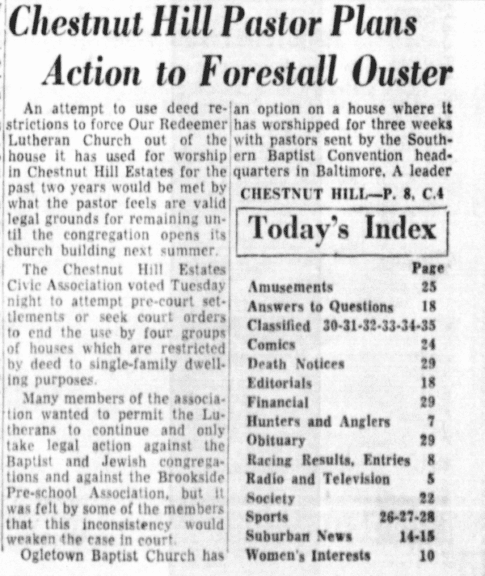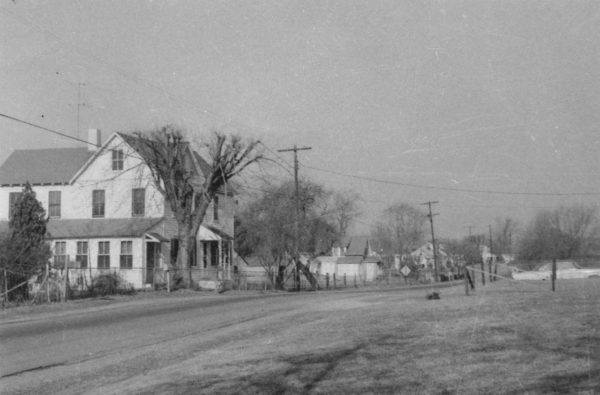A History Yet to be Written

One Thanksgiving in the late 80s, when I was in high school, our family decided to spend the day out of town. We drove two hours away, enjoyed a championship soccer game and a huge afternoon meal, for which we were all very thankful. As I reflect on this day, I think the outing was my father’s way to serve my mother, one of the hardest working ladies I’ve ever met. This special day and meal were hers to enjoy, not to prepare.

The house where OBC started in July 1958 and met for almost one year: 16 W. Stephens Drive (Newark) in Chestnut Hill Estates. (photo submitted by Champ Thornton)
That day I also ran into a former teacher. He hadn’t seen me in years and wanted to know how I was doing in school. He asked, “Are you more of an English/History guy or a Science/Math guy?”
“I don’t know,” I shrugged. “Neither, I guess.” Back then the truth was, I didn’t care for English, History, Science, or Math. While the intervening decades haven’t much improved my love for science or math, I have come to see words (English) and words about the past (History) in a different light. What changed my perception? God’s Word — brimming with words and history.
The Bible contains a torrent of words. The ESV (English Standard Version), for example, packs 757,439 words between Genesis 1:1 and Revelation 22:21. That’s a lot of English! And almost half is history! The Bible Project estimates that 43% of God’s Word is historical narrative.
Yet biblical history doesn’t list dry facts and dusty dates. When the Bible presents the past, it blazes from the pulpit. It’s no accident that the historical books of the Old Testament—think Joshua through 2 Kings—are actually, in the Hebrew Scriptures, part of “The Former Prophets.” God recalls the past as a way to preach to us in the present.
The New Testament takes the same approach. The Gospels proclaim the good news of Jesus Christ—not just to teach us, but to shape how we live and how we think. Isn’t this Paul’s point in Romans 8:32? “He who did not spare his own Son but gave him up for us all, how will he not also with him graciously give us all things?” (ESV)
We remember the life of Christ given for us—not merely to recall that glorious sacrifice, but to make logical inferences for today from that gracious and historical event in the past:
- God gave His Son for us freely, and . . . [in the past]
- His Son was the most costly gift He could give; therefore, . . .
- God will also give us less costly things we need. [in the present]
We look back in order to look forward. We recall what we know God has done in history—in order to face what we do not know in the future.
We should read biblical history in this way — one eye looking back, one eye looking ahead. And we can also read church history this way as well. As God has never failed to provide in the past, He will continue to provide into the future.
Ogletown Baptist Church: A picture of God’s faithfulness
Here’s just one example of God’s faithfulness not merely in church history generally but in the history of one church specifically. In 2018, Ogletown Baptist Church (OGB) in Newark, Delaware, celebrated its 60th anniversary. In preparation for that celebration, I enjoyed unearthing the stories of its founding. With a view of how God continues to sustain today and into tomorrow, here’s a sample of that historical beginning:
On July 20, 1958, five families — mostly DuPont transfers from the South — began meeting for worship in a 1275-square-foot house they had rented in Chestnut Hill Estates in the part of Newark, Delaware, known as Ogletown.

Newspaper article from The News Journal (Wilmington, DE), describing the problems between the Chestnut Hill Estate’s civic association and several start-up ministries (Thursday, August 7, 1958) “chapter 1 title page old white house and farmland”
Within two months, forty-seven people were regularly trying to squeeze into the small rented house at 16 W. Stephens Drive. And in less than a year, one service had crammed in eighty-five men, women, and children. The church investigated renting an additional house next door, but although 18 W. Stephens Drive was available, larger factors ruled out this possibility.
Less than a month after starting, Chestnut Hill’s civic association took action not only against the start-up church but against the three other ministries using houses in that development. In a local newspaper, the association president said, “We have nothing against any of these organizations, but if we don’t stop this practice now, there’s no telling where it will end.”
With less than 50 regular attendees and less than $400 in the bank, the little church, then known as Ogletown Baptist Mission, didn’t have a good option. They had looked at several pieces of land and knew the centrally located parcel they wanted. Yet this property, a farm at 316 Red Mill Road — offering a two-story farmhouse in which to meet, three acres for parking and growth, and a location within easy driving distance for the 12,000 people living within a three-mile radius—was unavailable.
Seventy-five-year-old widower Herbert Crossan had lived on his farm on Red Mill Road since 1939. Ogletown leaders had talked to Mr. Crossan about his land. And although a life-long Methodist, Herbert Crossan had told his children he wanted the new Baptist church to be able to buy his farm when it became available at some later day in the distant future.
But at the present, Ogletown didn’t even know about tomorrow. On September 1, 1959, leaders and attorneys from both the church and the Chestnut Hill civic association finally met in person to decide what would happen to the then two-month-old congregation. When the meeting was over, it was agreed: that the church would have to vacate the rented house in Chestnut Hill Estate within 23 months.
Four days later, Herbert Crossan passed away. As his estate was being settled, his children held the property for Ogletown, but the price, at $15,000, was more than the church could afford and three times the average market price! To buy this ideal property, the church would need a substantial loan.
Yet church members soon discovered that banks in Delaware were not friendly to this new Southern Baptist church. They did not want to loan a tiny congregation, which had not even been officially constituted, $15,000 for a property possibly worth less than the amount loaned. As a later Ogletown pastor, Marvin Ford, recalled, “The banks had said, ‘If you were a liquor store, we’d loan it to you. But,” Marvin continued, “Ogletown began with a group of people who believed in God, who stepped out in faith.”

A photograph of the farmhouse and surrounding land, situated on Red Mill Road and belonging to Herbert and Virginia Crossan; purchased by Ogletown Baptist in May 1959, the house became OBC’s first meeting location on the new property at 16 West Stephens drive exterior-vintage (Photo submitted by Champ Thornton)
So while the Crossan family held the land, the church searched for some source of funding. In December of that year, Ogletown deacon, Howard Bowman, met in Atlanta with the head of Southern Baptist church planting, Dr. Frank Garrison. Would the SBC be able to loan the money? There was only $86,000 available within the entire denominational budget to fund church planting. And $52,000 of that amount had already been allocated, and over 100 churches already stood in line for some portion of the rest.
Yet God had been guiding each step of the path. When Howard Bowman returned home to Delaware, he gathered the church and told them what had happened. God had prepared the way: “The Lord had preceded me to Atlanta,” he said. Mr. Bowman then recalled how he and Dr. Garrison had talked for an hour and a half, and when they were done, Ogletown had its loan for the full $15,000!
When the Ogletown church family heard the news of God’s provision, they rejoiced! Of that miraculous moment, they wrote, “Needless to say, our hearts were filled with thankfulness to God for his continued goodness to us and most especially for answered prayer. How humble we feel at such a wonderful evidence of the ‘the Lord’s doing.’”
When there was no money, when options were few, when time was running out, God had shown Himself faithful to provide. Six months later, Ogletown held its first service in the old Crossan farmhouse, less than 11 months after they had started. For the remainder of their history, the members of Ogletown Baptist Church could look back on how God had provided, recognize His faithfulness because of Christ, and find hope for a history that was yet to be written.
Champ Thornton served as an associate pastor at Ogletown Baptist Church in Delaware for 12 years. He is also the author of “Age to Age,” about the history of the Delaware Baptist Association, and “By the Book: A History of Ogletown Baptist Church.” He has also written children’s books and devotionals. Check out all of his offerings on his website – champthornton.com.
Feature photo by Katie Hall (used with permission)
